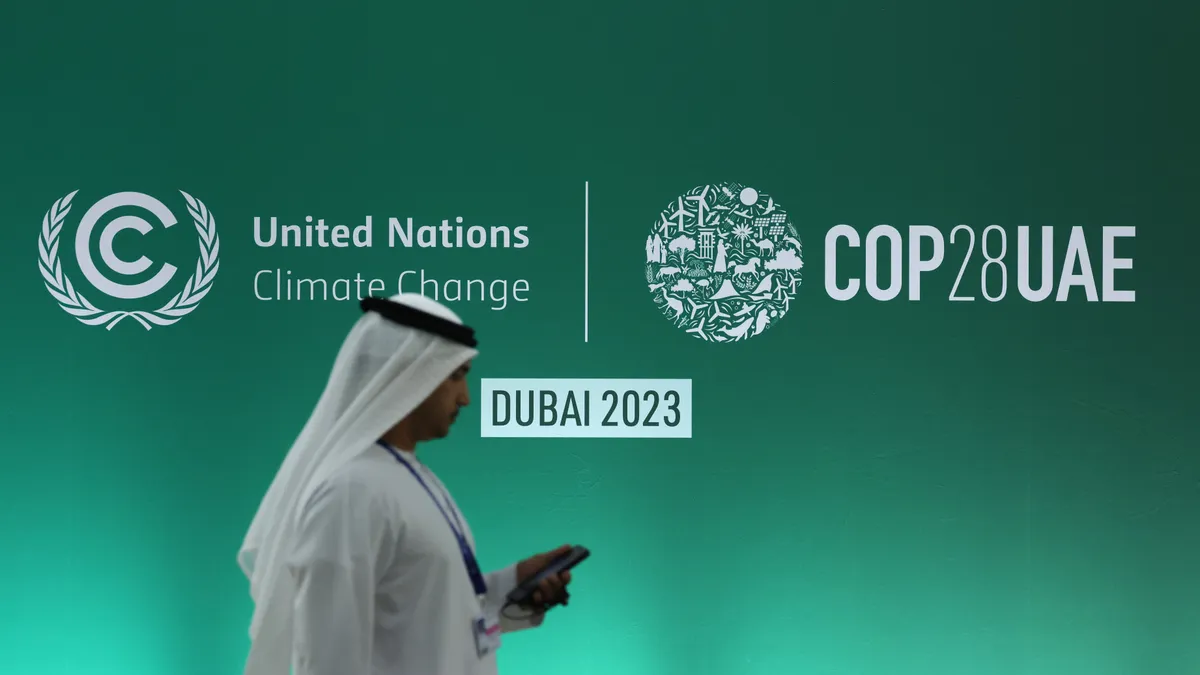Dive Brief:
- Measures that decrease the power consumption of cooling equipment could slash at least 60% of predicted 2050 emissions from cooling, according to a new report from the Cool Coalition, a group of more than 130 government, nonprofit and private-sector partners led by the United Nations Environment Programme.
- The three priority measures the report identifies — passive cooling, higher energy efficiency standards and a quicker phasedown of climate-warming refrigerants — if paired with rapid power grid decarbonization, could result in up to 96% in emissions reductions from the cooling sector, according to the Global Cooling Watch report that the group published during the COP28 climate talks in Dubai, United Arab Emirates.
- Fully implementing these measures worldwide could also save $1 trillion by 2050 and reduce global peak power requirements by 1.5 terawatts to 2 terawatts, eliminating the need for $4 trillion to $5 trillion in power generation investments, the report states.
Dive Insight:
Cooling equipment accounts for 20% of total electricity consumption today and is expected to more than double by 2050, the UNEP said in a Dec. 5 news release.
Based on current policies, the installed capacity of cooling equipment globally will triple between now and 2050, the report says. That means emissions from cooling could surge to 6.1 billion tons of carbon dioxide equivalent in 2050, further contributing to climate change.
Passive cooling measures that can minimize heat intrusion while maintaining indoor thermal comfort and temperatures in cold storage include improved insulation, reflective surfaces, thermal mass, nature and building design shading, natural ventilation, landscaping, building orientation and optimized specifications for doors and windows, the report states. It recommends that building energy codes explicitly incorporate these measures and also that such codes be used to drive the transition to efficient cooling equipment with low global warming potential. The report noted that these measures can cut 1.3 billion tons of carbon dioxide equivalents by 2050 and curb cooling capacity demand growth by 24% in that period, saving between $1.5 trillion and $3 trillion that would otherwise be incurred on new cooling equipment costs.
Installing and operating highly energy efficient cooling equipment, coupled with passive cooling load reductions, could bring 2050 electricity use for stationary cooling equipment below 2022 levels. But, to achieve that reduction, the global average efficiency of all cooling equipment operating in 2050 would need to be nearly triple the average efficiency of equipment operating today. The report suggests that the efficiency of cooling products can be increased most effectively when minimum energy performance standards are combined with effective product labeling and financial instruments aimed at bolstering demand for higher-efficiency products.
Phasing down climate-warming refrigerants by pushing for a more rapid uptake of low-GWP technologies in all new equipment and enhancing refrigerant lifecycle management to prevent leakages and end-of-life emissions, is the third set of measures that the report prioritizes. Such actions could halve hydrofluorocarbon emissions in 2050 compared with a timeline set previously, the report stated, calling for stronger regulations on refrigerant recovery during servicing or disposal.
Michael Powell, vice president and general manager of Modine Coatings, recommends that facilities managers and HVAC technicians consider microchannel coils for higher energy efficiency, as they use significantly less refrigerant. “Manufacturers are addressing federal regulations for energy efficiency of the equipment by moving to microchannel coils, which look like automotive radiators, as opposed to copper-tube coils,” Powell said in an interview. However, their all-aluminum composition makes them more prone to corrosion, as their walls are much thinner than those of traditional copper coils, he added.
The private sector is instrumental in financing and driving innovation to advance sustainable cooling, Makhtar Diop, managing director at the International Finance Corp., said in the release.
The report proposes a double-pronged approach to enabling action on cooling that leverages both the public and private sector. The first step involves incorporating cooling into legislative frameworks and developing national cooling action plans. The second step involves streamlining funding mechanisms to facilitate the transition to high-efficiency solutions. Business models and financing instruments that the report identifies to make this transition more economically feasible include cooling-as-a-service, energy service company financing, district cooling and on-bill financing. These strategies, the report said, can help leverage lifecycle cost savings that result from significant emissions reductions and lower upfront costs for businesses and consumers.














